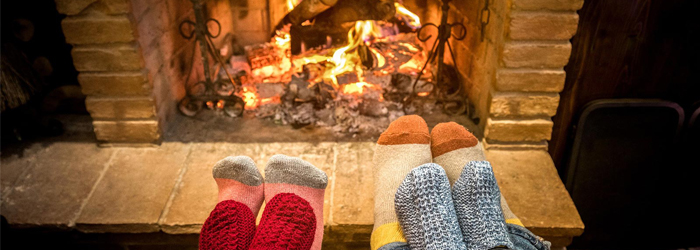Nothing brings warmth to a winter home and sets a cozy scene quite like lighting a fire in your fireplace. But before you grab your firewood or kindling, or reach for the gas knob, it’s important that you keep in mind the hazards that can come with both wood burning and gas fireplaces. In this guide, we’ll cover all of the safety precautions that you should take with your fireplace and chimney to ensure you stay safe while keeping warm.
Know the Hazards
When lighting a fire in your home this winter, keep in mind that you’re literally playing with fire. Since a small flame can turn into a major fire in just under 30 seconds, it’s important that you know all of the risks that come with fire and how to prevent them.
- Chimney Fires: While fireplaces are designed to keep fires contained, they can also bring risk to your home if your fireplace and chimney are not properly maintained. Each time a fire burns in your fireplace, a residue called creosote accumulates on the walls of your chimney. If a chimney is not properly cleaned to remove this buildup, your chimney is at risk of catching fire.
- Gas Leaks: While gas fireplaces can be safer than wood-burning fireplaces in some instances, they carry their own risk. Gas fireplaces, like other gas-powered appliances, produce carbon monoxide. According to the CDC, at least 430 people die from accidental carbon monoxide poisoning each year and approximately 50,000 are hospitalized.
- Hazardous Smoke: Though wood-burning fireplaces are designed to safely burn wood in the comfort of your home, the smoke emitted from burning wood is actually quite toxic. According to the American Lung Association, emissions from wood smoke can cause coughing, wheezing, asthma attacks, and other serious health effects.
Safeguard Your Home
With such serious potential repercussions to the safety and health of your home and your family, it’s best to be overly cautious when utilizing a fireplace. Below, we’ll cover the steps to take to ensure that your fireplace is safe to enjoy.
- Have chimneys regularly inspected and cleaned. To check for the buildup of creosote and to ensure that your fireplace is safe to use, it’s recommended that you have your fireplace and chimney inspected and professionally cleaned at least once a year. Even gas fireplaces require annual inspection and maintenance to ensure safety.
- Check on your fire alarms and carbon monoxide detectors. At the first sign of cool weather in your neighborhood, test both your fire alarm and carbon monoxide detector to ensure that they are functioning properly and replace batteries to ensure they stay charged and functioning throughout the season.
- Install or maintain a chimney cap. Chimney caps are a great way to keep from chimney free of debris and unwanted critters. They also can help catch potential sparks from your fire and prevent water from entering your chimney. Prior to making any purchases or arranging an installation of a chimney cap, just be sure to submit a request to your association’s Architectural Control Committee first to obtain the proper approval!
- Clear a path. Keep the top of your chimney free of any debris or tree branches that may overhang and potentially catch fire. Also, ensure that the hearth and immediate area surrounding your fireplace is clear of any decorations or clutter prior to starting a fire.
- Utilize fireplace screens/doors to help regulate heat and prevent any embers from escaping your fireplace.
- Only burn firewood. Only burn dry, seasoned firewood and safe kindling materials in the fireplace. Burning the wrong materials in your fireplace can either be a fire hazard or could lead to toxic fumes.
- Never leave fire unattended—especially around children. Fires are unpredictable, even when they appear to be dwindling. Prior to leaving the home or going to sleep, ensure that the fire in your fireplace is fully extinguished.
- Regularly clean out ashes. Each week you burn a fire in a wood-burning fireplace, the ashes will need to be removed. However, be sure that ashes are completely cool prior to removing them. Some ashes can take several days to cool completely.
- Stay properly ventilated. Since the fumes from burning wood can be toxic, it’s important to ensure that the room where your fireplace is located is properly ventilated. Ensure that the fireplace flue is open to allow smoke to properly escape, run any ceiling fans to keep air moving, and, if possible, crack a window open to allow for proper air circulation.
We hope that these tips help keep your family and your home protected all winter-long while enjoying the warmth from your home’s hearth. For more tips on keeping your home protected, subscribe to our blog today!

